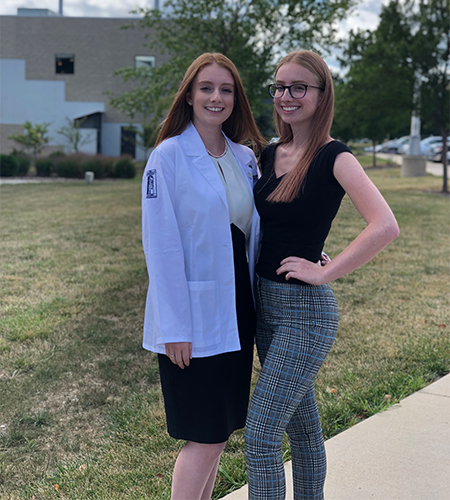Before starting her freshman year at The University of Toledo, Abigail Royfman took a chance to jump-start a competitive edge on her college career.
She contacted Dr. Tomer Avidor-Reiss, professor of biological sciences at UToledo and a groundbreaking scientist in the field of male infertility, asking for a research position in his laboratory.

CELEBRATING SUCCESS: UToledo recognizes the Class of 2022 with a series of stories featuring students receiving their degrees at fall commencement.
“I knew it was going to be a big change going from high school to college, so I wanted to pursue research early on to better orient myself. Despite having no research experience, I decided to put myself out there,” Royfman said. “I’ve found that it’s better to put yourself out there and ask for something. The worst that can happen is someone says no, and I believe rejection is an insignificant consequence when considering you may receive the opportunity of a lifetime.”
Avidor-Reiss said yes.
After graduating from Sylvania Southview High School and two months before the start of her first year at UToledo in the College of Natural Sciences and Mathematics and the Jesup Scott Honors College, Royfman spent her summer on campus finding her research footing.
That bold initiative paid off. In her nearly four years of working as an undergraduate researcher in Avidor-Reiss’ lab, the biology major and chemistry minor gained access to research equipment typically reserved for graduate students, postdocs and research professors.
Set to graduate Saturday, Dec. 17, with a bachelor’s degree in biology, Royfman will next go to medical school at UToledo after taking a semester off.
“Abigail is an outstanding and exceptionally strong student,” Avidor-Reiss said. “Since the beginning, she has shown phenomenal dedication. Her research contributes to the understanding of unexplained male infertility. In a short time, she learned to do immunofluorescent experiments on bovines and independently use the STORM super-resolution microscopy.”
Super-resolution fluorescence microscopy is a new technology that shattered the limits of optical resolution and allows for the unprecedented imaging of proteins. This technology’s developers received a Nobel prize a few years ago for its development.
“Abigail was probably one of the few first-year students in the world who used this highly sophisticated microscope,” Avidor-Reiss said. “She is such a strong undergrad student that I asked her to lead the writing as first author of a chapter that explains the method of how to perform structural and functional analysis of sperm centrioles using STORM.”
A centriole is a critical structure in sperm that plays a vital role in fertilization.
The paper with Royfman as first author is currently under review for publication in a Springer book. She also co-authored a published paper in 2021 in Nature Communications about the laboratory’s discovery that, contrary to popular belief, the sperm centriole moves.
“I’m honored to have received the opportunity to train on and use the microscope,” Royfman said. “It was terrifying at first to operate such advanced and expensive technology. I was even scared to click on or adjust anything outside of my training. Its high resolution is what’s unique about this microscope and has given us new insight on the sperm centrioles.”
She quickly overcame her fear of pushing buttons and gained comfort using and troubleshooting STORM to examine the subcellular structure of sperm.
“It was really cool to disprove a common scientific assumption,” Royfman said. “There is indeed movement in the sperm centriole — causing head twitching or head kinking — which is something we didn’t see before. I’m very grateful to have contributed to the discovery and published paper. I worked under Dr. Sushil Khanal, who was a graduate student at the time and is now a postdoctoral fellow in California. He provided me the guidance and training that has allowed me to function independently and extend upon this discovery for my final two semesters in the laboratory.”
Royfman said she chose UToledo because it keeps her close to home and her strong support system.

Abigail Royfman, right, will next go to medical school at UToledo, following in the footsteps of her older sister, Rachel, who is graduating from medical school at UToledo this year.
Plus, she was drawn to the BACC2MD program, UToledo’s early medical school pathway program offered to high-metric high school students, providing them the opportunity for an early interview with the UToledo College of Medicine and Life Sciences M.D. program following their sophomore year at UToledo.
“Getting an early interview and early acceptance to medical school has taken a lot of stress off my shoulders,” Royfman said. “For my career, I’m looking at a surgical specialty because I like working with my hands, as required by my hobbies of pottery and painting. Although, I’m open to any specialty that piques my interest in medical school.”
She is following in her sister’s footsteps.
“My sister is a trailblazer,” Royfman said. “Rachel, who is three years older than me and graduated high school a year early, is graduating from medical school at UToledo this year. I owe a lot of who I am to her today. She has forged the way for me and has always been there for me.”
Aside from her busy class and research schedule, during her time as an undergraduate Royfman volunteered at American Red Cross blood drives and participated in painting projects with memory care patients at a local nursing home.
As she prepares to cross the stage and achieve her academic degree, Royfman said she is grateful for Avidor-Reiss, who saw something special in a high school senior four years ago and welcomed a rookie into his laboratory.
“I’m thankful that he believed in me, especially as I wasn’t even in college yet,” Royfman said. “It has been an invaluable experience to be part of a collaborative, supportive environment that encouraged me to continue in the face of difficulties and pushed me to reach my fullest potential. I would not be the student I am today without his mentorship.”